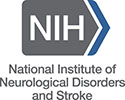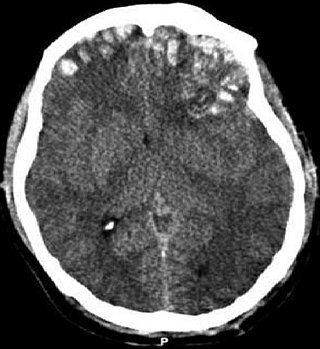Related Research Articles

The National Institute of Neurological Disorders and Stroke (NINDS) is a part of the U.S. National Institutes of Health (NIH). It conducts and funds research on brain and nervous system disorders and has a budget of just over US$2.03 billion. The mission of NINDS is "to reduce the burden of neurological disease—a burden borne by every age group, every segment of society, and people all over the world". NINDS has established two major branches for research: an extramural branch that funds studies outside the NIH, and an intramural branch that funds research inside the NIH. Most of NINDS' budget goes to fund extramural research. NINDS' basic science research focuses on studies of the fundamental biology of the brain and nervous system, genetics, neurodegeneration, learning and memory, motor control, brain repair, and synapses. NINDS also funds clinical research related to diseases and disorders of the brain and nervous system, e.g. AIDS, Alzheimer's disease, epilepsy, muscular dystrophy, multiple sclerosis, Parkinson's disease, spinal cord injury, stroke, and traumatic brain injury.

A concussion, also known as a mild traumatic brain injury (mTBI), is a head injury that temporarily affects brain functioning. Symptoms may include loss of consciousness; memory loss; headaches; difficulty with thinking, concentration, or balance; nausea; blurred vision; dizziness; sleep disturbances, and mood changes. Any of these symptoms may begin immediately, or appear days after the injury. Concussion should be suspected if a person indirectly or directly hits their head and experiences any of the symptoms of concussion. Symptoms of a concussion may be delayed by 1–2 days after the accident. It is not unusual for symptoms to last 2 weeks in adults and 4 weeks in children. Fewer than 10% of sports-related concussions among children are associated with loss of consciousness.

A traumatic brain injury (TBI), also known as an intracranial injury, is an injury to the brain caused by an external force. TBI can be classified based on severity ranging from mild traumatic brain injury (mTBI/concussion) to severe traumatic brain injury. TBI can also be characterized based on mechanism or other features. Head injury is a broader category that may involve damage to other structures such as the scalp and skull. TBI can result in physical, cognitive, social, emotional and behavioral symptoms, and outcomes can range from complete recovery to permanent disability or death.

Christopher John Nowinski is an American neuroscientist, author and retired professional wrestler. After extensively researching concussions in American football, Nowinski co-founded the Concussion Legacy Foundation, where he is currently CEO and co-founded Boston University's CTE Center. As a professional wrestler, he is best known for his tenure with World Wrestling Entertainment (WWE) under the ring name Chris Harvard and later under his real name.
Post-concussion syndrome (PCS), also known as persisting symptoms after concussion, is a set of symptoms that may continue for weeks, months, or years after a concussion. PCS is medically classified as a mild traumatic brain injury (TBI). About 35% of people with concussion experience persistent or prolonged symptoms 3 to 6 months after injury. Prolonged concussion is defined as having concussion symptoms for over four weeks following the first accident in youth and for weeks or months in adults.

Chronic traumatic encephalopathy (CTE) is a neurodegenerative disease linked to repeated trauma to the head. The encephalopathy symptoms can include behavioral problems, mood problems, and problems with thinking. The disease often gets worse over time and can result in dementia.

Ayub Khan Ommaya, MD, ScD (hc), FRCS, FACS was a Pakistani American neurosurgeon and the inventor of the Ommaya reservoir. The reservoir is used to provide chemotherapy directly to the tumor site for brain tumors. Ommaya was also a leading expert in traumatic brain injuries.
Second-impact syndrome (SIS) occurs when the brain swells rapidly, and catastrophically, after a person has a second concussion before symptoms from an earlier one have subsided. This second blow may occur minutes, days, or weeks after an initial concussion, and even the mildest grade of concussion can lead to second impact syndrome. The condition is often fatal, and almost everyone who is not killed is severely disabled. The cause of SIS is uncertain, but it is thought that the brain's arterioles lose their ability to regulate their diameter, and therefore lose control over cerebral blood flow, causing massive cerebral edema.
Post-traumatic amnesia (PTA) is a state of confusion that occurs immediately following a traumatic brain injury (TBI) in which the injured person is disoriented and unable to remember events that occur after the injury. The person may be unable to state their name, where they are, and what time it is. When continuous memory returns, PTA is considered to have resolved. While PTA lasts, new events cannot be stored in the memory. About a third of patients with mild head injury are reported to have "islands of memory", in which the patient can recall only some events. During PTA, the patient's consciousness is "clouded". Because PTA involves confusion in addition to the memory loss typical of amnesia, the term "post-traumatic confusional state" has been proposed as an alternative.
Traumatic brain injury can cause a variety of complications, health effects that are not TBI themselves but that result from it. The risk of complications increases with the severity of the trauma; however even mild traumatic brain injury can result in disabilities that interfere with social interactions, employment, and everyday living. TBI can cause a variety of problems including physical, cognitive, emotional, and behavioral complications.

Prevention of mild traumatic brain injury involves taking general measures to prevent traumatic brain injury, such as wearing seat belts, using airbags in cars, securing heavy furnitures and objects before earthquake or covering and holding under the table during an earthquake. Older people are encouraged to try to prevent falls, for example by keeping floors free of clutter and wearing thin, flat, shoes with hard soles that do not interfere with balance.

Dr. Bennet Ifeakandu Omalu is a Nigerian-American physician, forensic pathologist and neuropathologist who was the first to discover and publish findings on chronic traumatic encephalopathy (CTE) in American football players while working at the Allegheny County coroner's office in Pittsburgh. He later became the chief medical examiner for San Joaquin County, California, and is a professor at the University of California, Davis, department of medical pathology and laboratory medicine. He is currently the President and Medical Director of Bennet Omalu Pathology.
Concussions and play-related head blows in American football have been shown to be the cause of chronic traumatic encephalopathy (CTE), which has led to player deaths and other debilitating symptoms after retirement, including memory loss, depression, anxiety, headaches, stress, and sleep disturbances.
Concussions, a type of mild traumatic brain injury, are a frequent concern for those playing sports, from children and teenagers to professional athletes. Repeated concussions are known to cause neurological disorders, particularly chronic traumatic encephalopathy (CTE), which in professional athletes has led to premature retirement, erratic behavior and even suicide. A sports-related concussion is defined as a "complex pathophysiological process affecting the brain, induced by biomechanical forces". Because concussions cannot be seen on X-rays or CT scans, attempts to prevent concussions have been difficult.
A traumatic brain injury (TBI) is a blow, jolt or penetration to the head that disrupts the function of the brain. Most TBIs are caused by falls, jumps, motor vehicle traffic crashes, being struck by a person or a blunt object, and assault. Student-athletes may be put at risk in school sports, creating concern about concussions and brain injury. A concussion can be caused by a direct blow to the head, or an indirect blow to the body that causes reactions in the brain. The result of a concussion is neurological impairment that may resolve spontaneously but may also have long-term consequences.
Most documented cases of chronic traumatic encephalopathy have occurred in many athletes involved in contact sports such as boxing, American football, wrestling, ice hockey, mixed martial arts, rugby and soccer. Other risk factors include being in the military, prior domestic violence, and repeated banging of the head. The exact amount of trauma required for the condition to occur is unknown. Below is a list of notable cases of CTE in sports.
The Australian Sports Brain Bank is a medical research laboratory, a part of the neuropathology department of the Royal Prince Alfred Hospital (RPA) in Sydney. It is headed by neuropathologist Associate Professor Michael Buckland.
A pediatric concussion, also known as pediatric mild traumatic brain injury (mTBI), is a head trauma that impacts the brain capacity. Concussion can affect functional, emotional, cognitive and physical factors and can occur in people of all ages. Symptoms following after the concussion vary and may include confusion, disorientation, lightheadedness, nausea, vomiting, blurred vision, loss of consciousness (LOC) and environment sensitivity. Concussion symptoms may vary based on the type, severity and location of the head injury. Concussion symptoms in infants, children, and adolescents often appear immediately after the injury, however, some symptoms may arise multiple days following the injury leading to a concussion. The majority of pediatric patients recover from the symptoms within one month following the injury. 10-30% of children and adolescents have a higher risk of a delayed recovery or of experiencing concussion symptoms that are persisting.
Michael J. Stuart is an American sports physician and orthopedic surgeon. He is a professor and vice-chairman of orthopedic surgery at the Mayo Clinic in Rochester, Minnesota and a co-director of the Mayo Clinic Sports Medicine Center. He has published more than 370 journal articles and 50 book chapters, as of 2022. He specializes in sports medicine, and advocates for strength, flexibility, and awareness, to reduce injuries in ice hockey. He collaborated to arrange the 2010, 2013 and 2017 Ice Hockey Summits, which focused on concussions, and educational programs for players, coaches and parents. His concussion research includes studying biomarkers, neuroimaging, and cognitive neuroscience. He argues that concussions are diagnosed more accurately with electroencephalography and the King-Devick Test eye test, and advocates their usage in sport.
Rosemarie Scolaro Moser is an American sports neuropsychologist and director of the Sports Concussion Center of New Jersey. She is the first female to receive the Distinguished Career Award from the Sports Neuropsychology Society (SNS) and the first elected female president of SNS.
References
- ↑ Surgeon Nancy Temkin: Traumatic brain injuries; Finding ways to reduce the damage, University of Washington, retrieved 2017-10-19
- 1 2 "Nancy Temkin", Faculty, University of Washington School of Public Health, retrieved 2017-10-19
- ↑ Extensive Study on Concussions in Youth Sports Finds 'Culture of Resistance' for Self-Reporting Injury; Not Enough Evidence to Support Claim That Helmets Reduce Concussion Risk, US National Academies, October 30, 2013, retrieved 2017-10-19
- 1 2 3 National Research Council, Institute of Medicine, Board on Children, Youth, and Families, Committee on Sports-Related Concussions in Youth (2014), Sports-Related Concussions in Youth: Improving the Science, Changing the Culture, National Academies Press, p. 2037, ISBN 9780309288033
{{citation}}: CS1 maint: multiple names: authors list (link) - ↑ "AES Distinguished Service Awardees", Epilepsy Research and Recognition Awardees, American Epilepsy Society, 2013-12-04, retrieved 2017-10-19